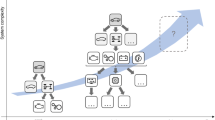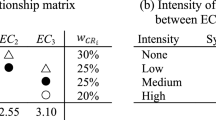Abstract
A collaborative design environment can be viewed as a multi-agent system where each design agent has knowledge about specific domains and can solve different problems. Several agents combine to solve a complex problem through knowledge sharing and inter operation. It is essential to construct an integrated knowledge base to improve the efficiency and consistency of complex problem-solving. An ontology-based knowledge integration framework in a collaborative design environment is presented in this paper. Ontology provides standard vocabulary, technical terminology and a domain model for knowledge integration. The representation and construction of ontology are critic problems for knowledge integration. An object-oriented concept graph representation is presented to represent ontology. It has advantages of both object-oriented methodology and Sowa’s conceptual graph. It can be translated into predicate calculus conveniently, and can represent the intension of concepts. In order to improve the efficiency of ontology construction, a semantic-based approach is presented. Firstly, a semantic affinity based clustering algorithm is presented to generate concepts from the term set of multi-agent systems. Then, ontology is constructed based on knowledge.
Similar content being viewed by others
References
Neches R, Fikes R, Finin T et al (1991) Enabling technology for knowledge sharing. AI Mag 12(3):36–56
Preece A, Hui K, Gray A et al (2000) The KRAFT architecture for knowledge fusion and transformation. Knowl-Based Syst 13:113–120
Sainter P, Oldham K, Kneebone S et al (1998) The necessity for product knowledge reuse and sharing within knowledge-based engineering systems. Proc DETC 98, Atlanta, GA, USA
Wang CH et al (2001) Acoverage-based genetic knowledge-integration strategy. Expert Syst Appl 19:9–17
Gruber T (1994) SRKB mailing list, http://www-ksl.stanford.edu/email-archives/srkb.messages/0.html
Gruber T (1993) Ontolingua: a translations approach to portable ontology specifications. Knowl Acquis 5(2):199–200
Lenat DB (1990) Cyc: towards programs with common sense. Commun ACM 33(8):30–49
MacGregor R (1991) Inside the LOOM classifier. SIGART Bull 2(3):70–76
Kifer M, Lausen G, Wu J (1995) Logical foundations of object-oriented and frame-based language. J ACM 42:741–843
McGuinness DL, Fikes R, Hendler J et al (2002) DAML+OIL: an ontology language for the semantic web. IEEE Intell Syst 9/10:72–80
WordNet 2.0. available at http://www.cogsci.princeton.edu/∼wn
Sowa JF (1984) Conceptual structure: information processing in mind and machine. Addison-Wesley, Boston
Sowa JF (2000) Knowledge representation: logical, philosophical and computational foundations. Brooks Cole, Pacific Grove, CA
Waterson A, Preece A (1999) Verifying ontological commitment in knowledge-based systems. Knowl-Based Syst 12(1–2):45–54
Uschold M, King M, Moralee S et al (1998) The enterprise ontology. Knowl Eng Rev 13(1):31–89
Fox MS, Barbuceanu M, Gruninger M (1996) An organisation ontology for enterprise modeling: preliminary concepts for linking structure and behaviour. Comput Ind 29:123–134
Lopez MF, Gomez-Perez A, Sierra JP et al (1999) Building a chemical ontology using methontology and the ontology design environment. IEEE Intell Syst 14(1):37–46
Roche C (2000) Corporate ontologies and concurrent engineering. J Mater Process Technol 107:187–193
Benetti H, Beneventano D, Bergamaschi S et al (2002) An information integration framework for e-commerce. IEEE Intell Syst 17(1):18–25
Bergamaschi S, Castano S, Vincini M et al (2001) Semantic integration of heterogeneous information sources. Data Knowl Eng 36(3):215–249
Navigli R, Velardi P (2003) Ontology learning and its application to automated terminology translation. IEEE Intell Syst 18(1):22–31
Basili R, Pazienza MT, Velardi P (1996) An empirical symbolic approach to natural language processing. Artif Intell 85(1–2):59–99
Zhou L, Booker QE, Zhang DS (2002) ROD–toward rapid ontology development for under developed domains. Proc 35th Int. Conf. On System Sciences, Hawaii, USA
Jennings NR, Sycara K, Wooldridge MJ (1998) A roadmap to agent research and development. Autonom Agents Multi-Agent Syst 1(1):7–38
Hong F (1983) Elements of discrete mathematics (Chinese). Press of Huazhong University of Science and Technology, Wuhan, PR China
Graham I (2003) Object-oriented methods: principle & practice. Pearson Education
Waterson A, Preece A (1999) Verifying ontological commitment in knowledge-based systems. Knowl-Based Syst 12(1–2):45–54
He XG (2002) Fuzzy theories and fuzzy techniques in knowledge processing (Chinese). Press of Defense Industry, Beijing, PR China
Lammari N, Métais E (2004) Building and maintaining ontologies: a set of algorithms. Data Knowl Eng 48:155–176
Genesereth MR, Fikes RE (1992) Knowledge interchange format, version 0.3, reference manual, logic-92-1, Knowledge Systems Lab., Stanford Univ
Miller GA (1993) Nouns in wordNet: a lexical inheritance system. http://www.cogsci.princeton.edu/∼wn
Dillon WR, Goldstein M (1984) Multivariate analysis: methods and applications. Wiley, New York
Acknowledgement
We gratefully acknowledge the support of NSFC (China) under grant 50475142.
Author information
Authors and Affiliations
Corresponding author
Rights and permissions
About this article
Cite this article
Ling, L., Hu, Y., Wang, X. et al. An ontology-based method for knowledge integration in a collaborative design environment. Int J Adv Manuf Technol 34, 843–856 (2007). https://doi.org/10.1007/s00170-006-0670-8
Received:
Accepted:
Published:
Issue Date:
DOI: https://doi.org/10.1007/s00170-006-0670-8




